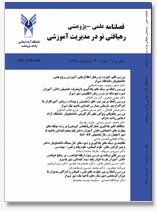امکان سنجی استقرار نظام آموزش ضمن خدمت مجازی در دانشگاه آزاد اسلامی
محورهای موضوعی : آموزش و پرورش
اسماعیل کاظم پور
1
*
![]() ,
خلیل غفاری
2
,
خلیل غفاری
2
1 - استادیار دانشگاه آزاد اسلامی واحد تنکابن
2 - استادیار دانشگاه آزاد اسلامی واحد الیگودرز
کلید واژه: امکان سنجی, آموزش مجازی, آموزش عالی, نظام آموزش ضمن خدمت,
چکیده مقاله :
هدف این پژوهش، امکان سنجی استقرار نظام آموزش ضمن خدمت مجازی در دانشگاه آزاد اسلامیاز دیدگاه اعضای هیأت علمیمنطقهی 3 بود. تحقیق حاضر، به روش پیمایشی انجام شد. جامعهی مورد مطالعه، کلیهی اعضای هیأت علمی تمام وقت و نیمه وقت 20 واحد دانشگاهی منطقهی سه به تعداد 1523 نفر بودند که براساس جدول کرجسی و مورگان تعداد 310 نفر اعضای هیأت علمی به روش تصادفی طبقهای به عنوان نمونه انتخاب شدند. ابزار جمعآوری دادهها، پرسشنامهای محقق ساخته 41 گویهای براساس مقیاس لیکرت بود که پس از تعیین روایی و محاسبه پایایی آن به میزان 0.86 به اجرا درآمد. جهت تحلیل دادهها از آمار توصیفی و استنباطی (آنووا و شفه، و کالموگروف- اسمیرنف و کروسکال والیس) استفاده شد. نتایج نشان داد که بین شرایط و امکانات استقرار نظام آموزش ضمن خدمت مجازی در واحدهای دانشگاهی مورد تحقیق، تفاوت معناداری وجود دارد. از طرفی تفاوت معناداری میان واحدهای دانشگاهی منطقهی 3 از نظر زمینههای کاربردی نظام آموزش ضمن خدمت مجازی وجود ندارد و عمدتاً در پاسخ دهی به سؤال دوم، آزمودنیها اتفاق نظر داشتند. در پاسخ به سؤال سوم پژوهش، پس از شناسایی موانع استقرار نظام آموزش ضمن خدمت مجازی، نتیجهگیری شد که تفاوت معناداری میان واحدهای دانشگاهی منطقهی 3 از نظر موانع استقرار نظام آموزش ضمن خدمت مجازی وجود دارد. در پاسخ به سؤال چهارم پژوهش، پس از شناسایی عوامل تسهیل کنندهی استقرار نظام آموزش ضمن خدمت مجازی نتیجهگیری شد که تفاوت معناداری میان واحدهای دانشگاهی منطقهی 3 وجود دارد.
The aim of this research was to explore the feasibility of establishing a virtual in-service training system in Islamic Azad University from the point of view of the faculty members in district three. 1523 full-time and part-time faculty members in 20 university branches in district three were the target population for this descriptive survey study. Based on Krejcie & Morgan’s table 310 faculty members were selected through stratified random sampling as the sample of the study. A Likert-type questionnaire with 41 closed questions developed by the current researchers was administered after determining its validity and reliability (0.86). Both descriptive and inferential statistics (ANOVA and Scheffe test, Kolmogorov-Smirnov test and Kruskal-Wallis) were used. As regards the first research question, a study of the circumstances & facilities for the establishment of the virtual in-service training system indicated that there was a significant difference among these circumstances and facilities for the establishment of the virtual in-service training system in different university branches in this research. With regard to the second research question, an identification of the applied contexts for the establishment of the virtual in-service training system showed that there was no significant difference among university branches in this regard. It is worth noting that respondents principally had the same idea as far as this question is concerned. Concerning the third research question, a diagnosis of obstacles to the establishment of the virtual in-service training system revealed that there was a significant difference among university branches in district three in regard to these obstacles. With respect to the forth research question, an identification of the facilitative factors for the establishment of the virtual in-service training system showed that there was a significant difference among university branches in district three with regard to these factors.

